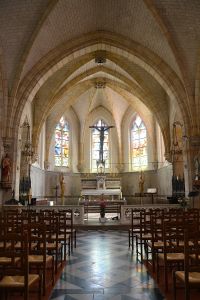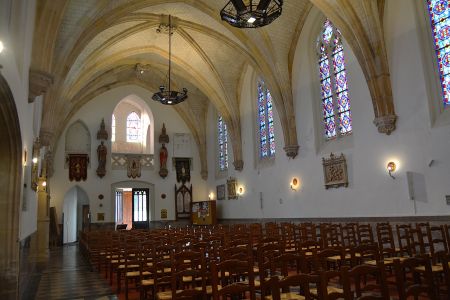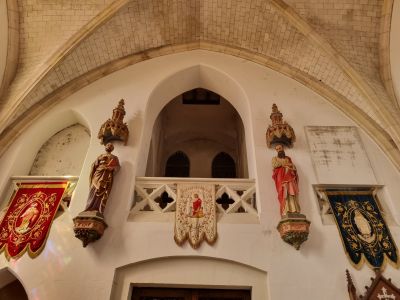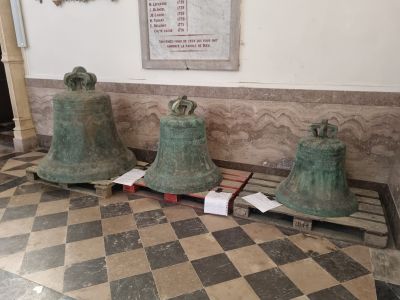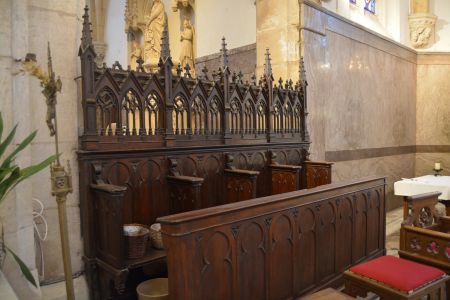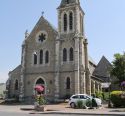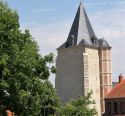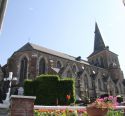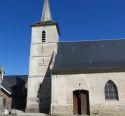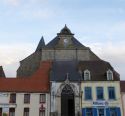Church | XVI-XIX | Neogothic | Catholic Church





Map
Opening hours
01 July - 30 September
Mon -
Tue -
Wed -
Thu 10.00 - 17.00
Fri 10.00 - 17.00
Sat 10.00 - 17.00
Sun -
01 December - 31 December
Mon
Tue
Wed
Thu
Fri
Sat 10.00 - 16.00
Sun 10.00 - 16.00
Guided tour
+33 3 21 33 79 30
Religious offices
Saturday 6 pm
Description
After a previous building dating from 15th to 16th century, the church of St. Martin in Rinxent was entirely rebuilt during the 19th century in stone from Marquise and Napoleon marble (two varieties of local marble), by the parish priest Father Guche. The work took place from 1860 to 1885.
In the neo-gothic style, the nave with cross-vaulting rests on carved corbels. But it is the quality of its furnishings and interior decoration which make the church exceptional. Among other elements of interest a magnificent monumental pulpit in carved stone can be seen. The sides show the attributes of the four evangelists and at the base are figures of the theological virtues. The main altar is of white marble, alabaster and gilded bronze. It is decorated with low relief carvings (Christ prepared for his tomb, under the altar table ; the Last Supper ; and Christ teaching).
Quite as remarkable are the altars of the side chapels, the confessional, the mosaic floor of the sanctuary, the stained glass windows (among which is one showing Father Guche with various religious personalities). The marble lacing of the communon banks must not be forgotten. Finally, in front of the left-hand side altar is a statue of Saint Wildeforte, a local saint who refused an arranged marriage and prayed to God to disfigure her beauty. Her wish was granted by the growing of a thick beard which covered her face, but her father caused her to die under torture. In Christian iconography she is the only saint who is shown crucified.
Photos
Media
Remarkable elements
Pulpit
A magnificent monument of finely carved stone. The hexagonal basin features the four evangelists on the visible sides. The foot is adorned with three figures representing the theological virtues: faith, the woman with the chalice; charity, the woman with the children; and hope, the woman with the anchor. All three are surmounted by a sculpted stone canopy.
Translated with www.DeepL.com/Translator (free version)
Statue - sainte Wilgeforte
An emblematic saint of the 2nd century, she refused to accept her father's wishes. Thrown into a dungeon, she prayed to God to dull her physical beauty; the beard invaded her face, disfiguring it. Her father was furious and tortured her to death. This saint is the object of a local pilgrimage.
Translated with www.DeepL.com/Translator (free version)
Altar in the choir
Made of white marble, it features three bas-reliefs: Christ laid before burial under the altar table, the Last Supper on the left-hand altarpiece and Christ teaching on the right-hand altarpiece. The tabernacle is surmounted by an expository with slender marble columns.
Translated with www.DeepL.com/Translator (free version)
The side altars
Two high-relief altars dedicated to Mary and Saint Joseph. Beneath each altar table is a bas-relief depicting scenes from the life of the holy family, in particular Saint Joseph dying between Jesus and Mary.
Translated with www.DeepL.com/Translator (free version)
The communion bench and choir floor
Since the liturgical reform of Vatican II, the communion bench no longer has the same function. Nevertheless, it remains a physical separation between the sacred space that is the choir and the nave, the space for the faithful. The latter is particularly remarkable for its white marble parapet, an alignment of pillars supporting ogives under an entablature. Just behind it is a beautiful mosaic decorated with scrolls of flowers.
Translated with www.DeepL.com/Translator (free version)



